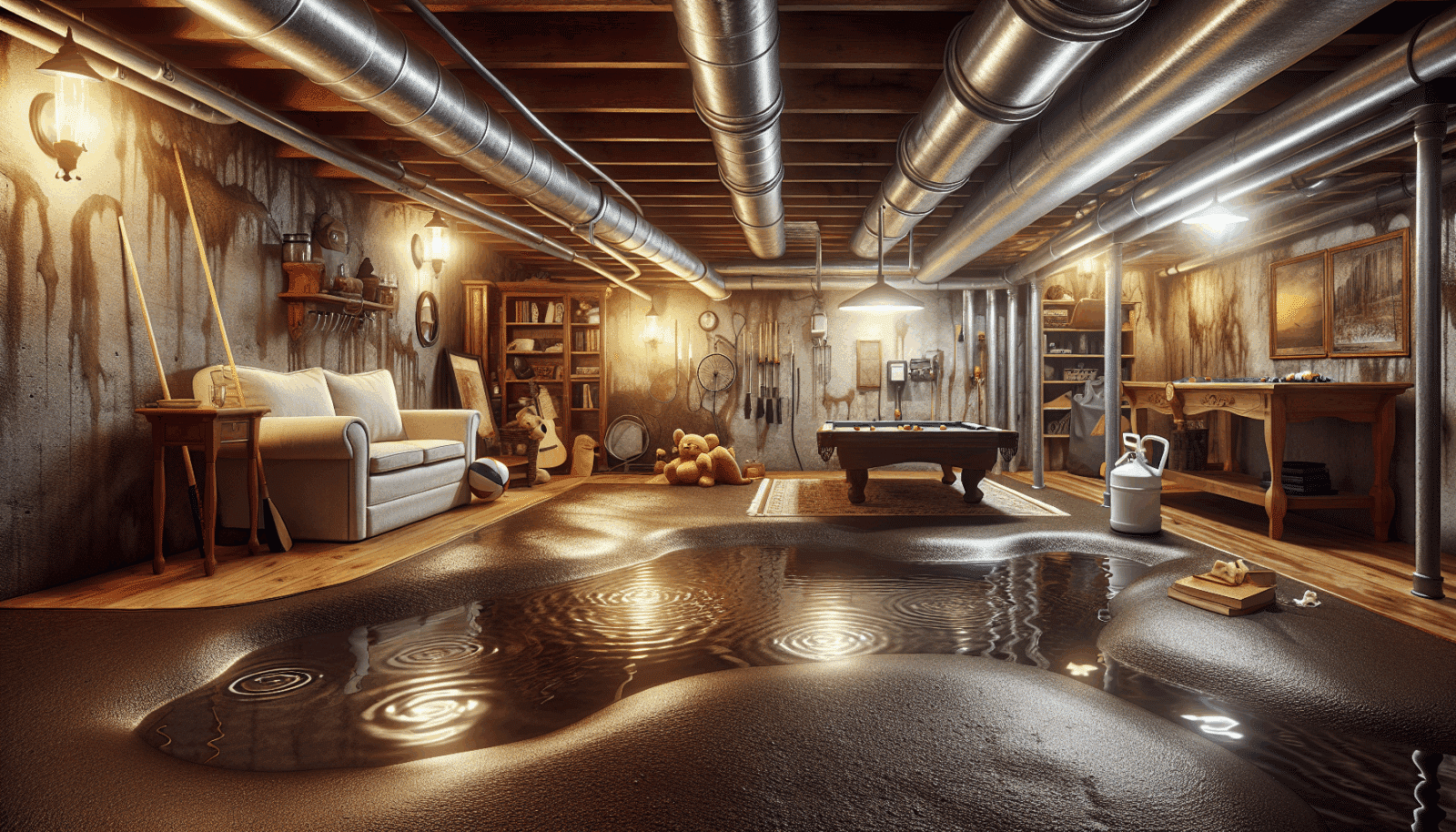At Utah Basement Finishing, we understand that a damp basement can be a major headache for homeowners. Moisture issues can lead to serious damage, mold growth, and a host of other problems. Fortunately, this ultimate guide to basement waterproofing solutions will set you on the right path. We’ll share expert tips to keep your basement dry, comfy, and safe for you and your family!
Contents
- 1 Understanding Basement Waterproofing
- 2 Signs You Need Basement Waterproofing
- 3 Interior Waterproofing Solutions
- 4 Exterior Waterproofing Solutions
- 5 Sump Pump Installation
- 6 Drain Tile Systems
- 7 Waterproofing Paints and Sealants
- 8 Landscape and Grading Solutions
- 9 Foundation Crack Repair
- 10 Maintenance Tips
- 11 Choosing Professional Services
Understanding Basement Waterproofing
Proper basement waterproofing involves techniques and materials designed to keep water out. It addresses leaks, seepage, and general dampness. In this section, we’ll explore the basics and why waterproofing is crucial for your home’s health.
Water can enter your basement in a variety of ways, ranging from floor cracks to poorly sealed Windows. Left untreated, moisture can compromise your home’s structural integrity and encourage mold growth. By understanding the importance of basement waterproofing, you’ll be better equipped to protect your space.
Whether you’re planning a remodel or simply want to tackle a moisture issue, having a waterproof basement safeguards your investment. It also provides a healthier environment by reducing allergens and toxins from mold. Now, let’s dive into the specifics!
Signs You Need Basement Waterproofing
Recognizing the early signs of moisture can save you time and money. Catching issues early helps avoid extensive repairs down the road. Here’s what to look for.
One of the clearest indicators of a moisture problem is standing water or visible dampness on the walls and floors. Additionally, a musty odor often points to hidden mold and mildew, another sign of excess moisture.
Other red flags include water stains, peeling paint, and efflorescence—a white powdery substance on your basement walls. Rust on appliances or furniture can also indicate that moisture levels are higher than they should be.
Interior Waterproofing Solutions
Interior waterproofing is key to managing water that has already made its way inside. These methods are typically Cost-effective and less disruptive to your home’s exterior landscaping.
One popular method is installing an interior drainage system. This involves placing pipes or drainage channels along the basement perimeter to direct water to a sump pump. Interior sealants can also be applied to walls to create a water-resistant barrier and reduce vapor transmission.
An additional technique is deploying a dehumidifier to control humidity levels within your basement. Keeping the air dry will reduce condensation and help prevent mold growth.
Exterior Waterproofing Solutions
Exterior waterproofing tackles the problem from the outside, stopping water from penetrating your basement walls. These solutions might require more upfront investment but offer long-term benefits.
A common approach is the installation of an exterior drainage system, often referred to as a French drain or weeping tile system. This method involves digging around the foundation and laying pipes to redirect water away from your home.
Another effective technique involves applying a waterproof membrane to the exterior walls. This barrier prevents water from seeping through the foundation and is often coupled with additional sealants for enhanced protection.
Sump Pump Installation
Sump pumps play a crucial role in keeping your basement dry. They automatically remove accumulated water from your basement, channeling it away from your property.
The installation process involves digging a sump pit in the lowest part of your basement and placing the pump inside. When the water level in the pit rises, the pump activates, directing the water outside through a discharge pipe.
There are various types of sump pumps, including pedestal and submersible models. Some even come with battery backups to ensure functionality during power outages, offering added peace of mind.
Drain Tile Systems
The role of a drain tile system is to manage water pressure and redirect moisture away from your foundation. These systems are effective for both new constructions and retrofit applications.
Drain tiles are typically installed along the perimeter of the foundation, either inside or outside. Pipes perforated with numerous small holes channel water into an aggregate trench, directing it away from your home.
These systems are particularly effective when used in conjunction with other waterproofing solutions, such as sump pumps and wall coatings, to provide a multi-faceted defense against water intrusion.
Waterproofing Paints and Sealants
Waterproofing paints and sealants offer a straightforward way to add an extra layer of protection to your basement walls and floors. They are an excellent supplementary measure to other waterproofing methods.
Waterproofing paints provide a barrier that stops water from penetrating through walls. Applying these paints is quick and can be completed as a DIY project for enthusiastic homeowners.
Sealants, on the other hand, are used to fill cracks and gaps where water might seep through. Some products are transparent, maintaining the original look of your walls, while others come in colors to match your decor.
Landscape and Grading Solutions
Your home’s exterior landscape also impacts basement moisture. Proper grading and drainage design can significantly reduce the risk of water infiltration.
Ensuring that the ground slopes away from your foundation is crucial. This prevents water from pooling near your home and seeping into the basement. Additionally, installing gutter extensions ensures that roof runoff is redirected away from the foundation.
Landscaping elements like swales and rain gardens can also help manage water. By directing excess rainwater into designated areas, you can avoid having it accumulate around your home’s perimeter.
Foundation Crack Repair
Cracks in your foundation are common entry points for water. Repairing these cracks is essential to your overall waterproofing effort.
There are several methods to address foundation cracks. Epoxy injections are a popular choice for sealing smaller cracks. This method not only fills the crack but also strengthens the structural integrity of the wall.
Larger cracks might require more extensive repair techniques, such as carbon fiber reinforcement or hydraulic cement application. These methods provide a permanent solution to foundation damage.
Maintenance Tips
Regular maintenance ensures the longevity of your waterproofing solutions. Staying proactive can save you from unexpected issues and costly repairs.
- Check and clean gutters regularly: This prevents clogs that can lead to water pooling around your foundation.
- Inspect sump pumps: Ensure they are working correctly and consider annual professional servicing for optimal performance.
- Monitor humidity levels: Use dehumidifiers to maintain a dry basement environment.
- Seal windows and doors: Make sure they are properly sealed to prevent water and air leaks.
- Inspect foundation and walls: Regularly check for new cracks or signs of moisture to address issues early.
Choosing Professional Services
While some waterproofing tasks can be DIY-friendly, hiring professionals ensures comprehensive and long-lasting results. Here’s why you might want to consider it.
Professionals bring industry expertise, specialized tools, and up-to-date knowledge to the table. Their experience allows them to identify potential problems that may go unnoticed by an untrained eye.
In addition to creating customized solutions for your specific needs, professional services can save you time and ensure that the job is done correctly the first time. This provides you with peace of mind and effectively protects your home.
Now that you’re equipped with this ultimate guide to basement waterproofing solutions, you can make informed decisions to keep your basement dry and secure. For further assistance or a professional hand, Contact Us at 801-515-3473 or Request a Free Quote.




